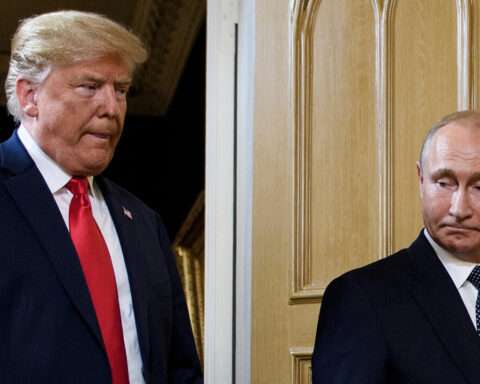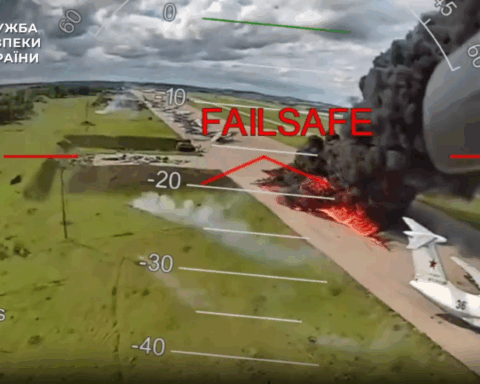Talk of war is again in the air. When Russia massed thousands of troops along its border with Ukraine last spring, reports and rumors swirled that the Kremlin might launch a big new offensive seven years after it seized control of Crimea and fomented a separatist war in the Donbas region that continues to this day.
Several months later, the same fears have surfaced with even greater force. Media including The New York Times and Bloomberg have cited U.S. officials as warning that Russia might attack this winter, with some saying a potential invasion could be “on a scale far greater” than in 2014.
The buildup of forces is evident in western Russia and also in Crimea, according to satellite images.
It’s impossible to ascertain exactly what Russia’s intentions are — or even whether President Vladimir Putin has made any specific plans or is, at this point, creating options. But here are some of the most important questions about the tense situation — and some possible answers.
Is there really a threat of major new Russian military action?
Yes — or at least, the evidence suggests it.
U.S. intelligence officials and senior figures in Ukraine’s military have suggested that as many as 92,000 Russian troops are massed to the north and east of Ukraine — many in the area around Yelnya, near Russia’s border with ally Belarus — and in Crimea, the peninsula that lies south of mainland Ukraine.
Amid Russia’s build-up, CNN this week quoted sources in U.S. President Joe Biden’s administration as saying it was considering sending military advisers and new equipment including weapons to Ukraine.
Earlier this month, U.S. Secretary of State Antony Blinken said that Washington had “real concerns” about the Russian military moves and a possible new offensive, which he warned would be a “serious mistake.”
While Moscow has dismissed talk of a potential Russian invasion as “groundless,” comments from an array of officials and analysts close to the Kremlin have sent a different and more dire message: that Russia may take action if Washington and the West do not address its ever more assertively stated concerns about the situation in the Donbas and, more broadly, NATO ties with Kyiv and Western military activity in Eastern Europe, the Black Sea, and elsewhere.
When Russia has launched offensives in the past, such as in Crimea and the Donbas in 2014 and in Georgia in 2008, it has claimed to have been provoked. And in recent weeks, Moscow has repeatedly accused Kyiv and the United States and its allies of provoking it, including with what NATO says have been long-planned exercises in Eastern Europe and routine naval missions in the Black Sea.
Meanwhile, the increased concerns about Russia’s intentions toward Ukraine do not stem from troop movements alone. In the past six months, Putin and several other senior officials have published incendiary articles about Ukraine, questioning its right to exist as an independent state and dismissing its democratically elected political leadership as “ignorant and unreliable.”
The secretary of the Kremlin’s Security Council, close Putin associate Nikolai Patrushev, asserted recently that what awaits Ukraine was an “Afghan scenario,” citing what he claimed was instability caused by weapons imports from the West and the purported danger of the country imploding. He cited no specific evidence.
And in a statement this week, Russia’s Foreign Intelligence Service denounced what it called U.S. “provocations” and ominously warned that “we observed a similar situation in Georgia ahead of the events of 2008” — when Russian forces drove deep into that country and then backed the independence declarations of two breakaway regions, leaving large numbers of troops in both of them.
In addition to sending signals to the West, such remarks may serve to ready Russians for potential new military action, analysts say.
“This is in large part aimed at a Russian domestic audience ahead of launching some major operation,” Mykhaylo Honchar, president of the Center for Global Studies Strategy XXI, a Kyiv-based think tank, told Current Time.
Why now?
Russia’s leadership may believe that it could take advantage of a volatile climate in the region, where Moscow’s own actions have contributed to recent tensions. Some analysts contend that this could make it easier for Russia to strike at Ukraine without meeting the kind of unified response it might at a calmer time.
Poland has been grappling with an influx of migrants, mostly from the Middle East, who have been lured to neighboring Belarus with promises of easy passage into the European Union. Even as it’s engaged in its own standoff with the EU over judicial independence, Warsaw has described the migrant crisis as an operation to destabilize Europe concocted by Belarusian strongman Alyaksandr Lukashenka with Putin’s blessing, a claim both Minsk and Moscow deny.
At the same time, Moldova has accused Russia of blackmail as it struggles to maintain energy supplies amid a natural-gas crunch, with Moscow saying the poorest country in Europe is not paying its bills. Critics also say Moscow has sought to demonstrate Europe’s reliance on its gas supplies as it ratchets up the pressure for Germany to approve the new Nord Stream 2 pipeline that would allow more Russian gas to bypass Ukraine en route to Europe.
Three are also worries that Moscow is seeking to increase tensions by claiming that NATO exercises and other military operations are deliberately provocative and show that the West is not willing to adhere to “red lines” cited by Putin.
In an interview with RFE/RL’s Romanian Service, NATO Deputy Secretary-General Mircea Geoana said that “everything we do near the Black Sea and on NATO’s eastern flank is of a purely defensive and absolutely transparent character.”
Meanwhile, Russia’s “red lines” have been shifting ominously in recent weeks and months, amounting to Kremlin demands that are increasingly unacceptable to NATO, Washington, and the West — and perhaps most of all to Ukraine, which Putin has made clear he does not want to be able to choose its partners or conduct its foreign policy as a sovereign country.
In the past, Russia made clear that NATO membership for Ukraine was a “red line” — but recently it has been warning against any expansion of the alliance’s military cooperation with Kyiv.
Alina Polyakova, president of the Center for European Policy Analysis, wrote on Twitter that in her assessment, “Moscow’s military intimidation is posturing for assurances of neutrality” of Ukraine, adding that “if that doesn’t happen, a military invasion is on the table.”
The show of force comes as the Kremlin seeks a new summit between Putin and Biden. Recent remarks suggest that Moscow might use such a meeting to press its case for sweeping “security guarantees” from the West, possibly including a pledge that Ukraine would never join NATO.
What would Russia’s goals be?
Increased influence in Ukraine, for one thing.
When Russia fomented unrest in the Donbas and backed forces that have held swaths of Ukraine’s Donetsk and Luhansk regions since the conflict there erupted in 2014, it was widely seen as an effort to leverage control over a relatively small part of Ukraine into powerful influence on the country’s government and foreign policy, including making certain it would never join NATO.
But as the Donbas war drags on with little or no progress toward implementation of Minsk-2 — a 2015 peace plan that could deeply undercut Kyiv’s power if carried out in accordance with the Kremlin’s wishes — Putin may fear that goal will never be achieved, leaving Russia with control over a piece of Ukraine but far short of the real prize — as much control over the country as possible.
In an article in Politico last week, Samuel Charap, a senior political scientist at the RAND Corporation think tank, quoted a former Russian lawmaker and diplomat as saying that “to get [the] Donbas but lose Ukraine would represent a defeat for the Kremlin.”
“The current buildup of forces suggests Moscow now believes that defeat is forthcoming,” Charap wrote. “Unless it escalates.”
“Russia might well be prepared to attack far deeper into Ukrainian territory and has the military capability to do so.”
While many analysts say that an attack aimed to take over all of Ukraine is extremely unlikely, some believe that Russia might seek to seize territory in eastern and even central Ukraine, possibly moving to control a swath of the south from the Russian border and the Donbas to Crimea, which it already holds.
Others think that Moscow would be more likely to limit itself to an escalation of the simmering war in the Donbas, which has killed more than 13,000 people since 2014, in a bid to force concessions from Kyiv without staging an open invasion that could lead to severe bloodshed and international opprobrium.
What does Russia stand to lose?
If Russia were to openly launch a new invasion of Ukraine, a strong Western reaction would be bound to follow. At a minimum, analysts argue, Moscow could expect a new round of sanctions and the almost certain collapse of Nord Stream 2, which Russia has expended great resources on and clearly sees as an economically and geopolitically crucial project.
If Russia were to invade Ukrainian cities with ground troops, a desperate fightback by Ukrainian forces — now far more experienced and better equipped than they were seven years ago — could lead to hundreds or even thousands of Russian soldiers returning home in body bags, a prospect that could give Putin pause as he seeks to build his legacy and possibly to remain president for years to come.
“There is no way that the [Russian] High Command cannot know that there would be many soldiers coming home crippled, wounded, or as ‘Cargo 200s’ — the dead,” author and analyst Mark Galeotti wrote recently in The Moscow Times.
“Nonetheless, if need be, the Russians could certainly build up a commanding force around Ukraine, and if Putin is willing to brave the international sanctions and condemnation and domestic outrage such a bloody war would generate, then an invasion can go ahead.”
Galeotti wrote that “if Putin really does fear Ukraine’s westward drift and, especially, the danger that NATO forces would begin to be emplaced in the country…then he may feel that delay will only make an eventual strike harder. Better to move sooner than later.”
“Then again, maybe this is all another piece of political theater to try and force Kyiv to negotiate with Moscow on its terms,” he added.
Is Putin bluffing?
That’s not clear yet. But a look at Russia’s past actions could potentially help parse the situation today and predict what might happen this winter.
Since Moscow’s seizure of Crimea and the start of the Donbas war, Western analysts and intelligence officials have warned more than once of a potentially imminent new Russian attack. No such offensive materialized amid the buildup last spring, and it ended up looking less like a prelude to a wider war than like a show of force ahead of negotiations with Biden’s administration and NATO exercises in Europe.
That may suggest that the current buildup, which in large part comprises forces that have remained in border areas since the previous moves in the spring, is part of Moscow’s policy of maintaining pressure on the West — as Putin suggested in recent remarks — and putting teeth behind its claims to be deeply concerned about NATO movements near its borders.
“Putin’s regime is operating on a razor’s edge, because it wants to launch Nord Stream 2 and if it starts even a covert military operation then this will ultimately mean the end of [that project],” Honchar said. “I think the main idea here might be just to show that Russia can do this.”






